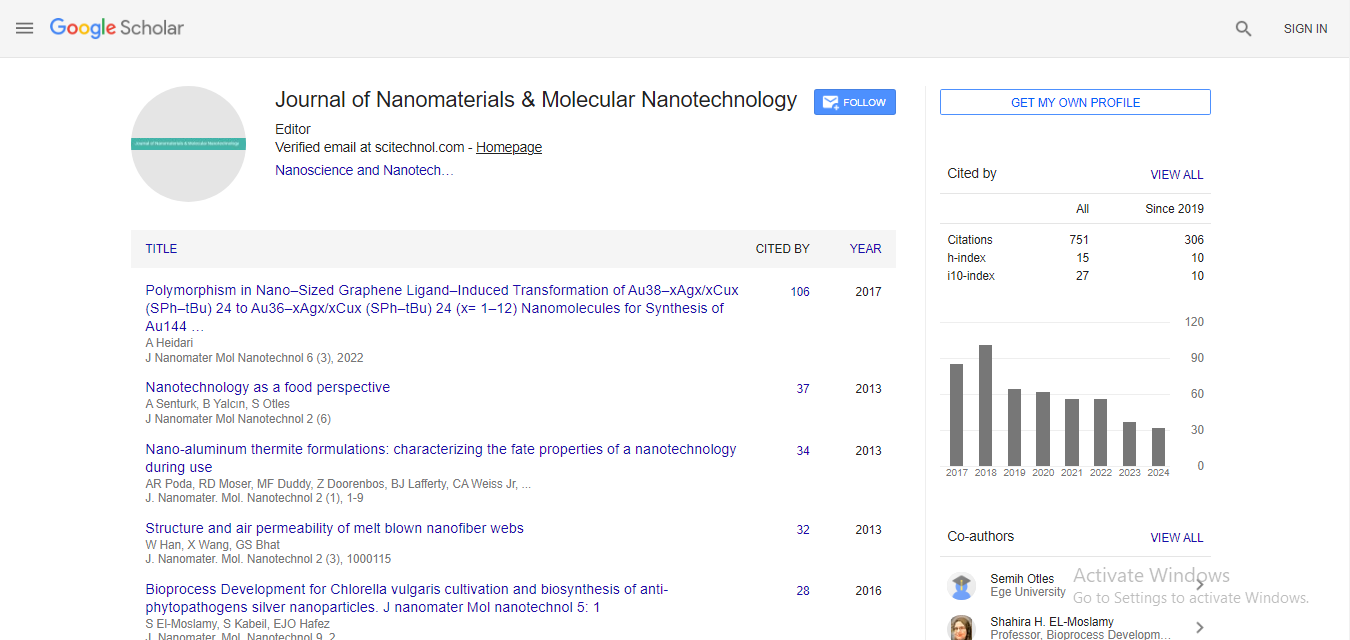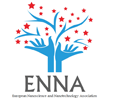NIR-responsive nanomaterials: key pieces and applications
Julia Perez-Prieto
University of Valencia, Spain
: J Nanomater Mol Nanotechnol
Abstract
Upconversion nanoparticles, where an inorganic matrix is doped with at least two trivalent lanthanide cations (e.g. NaYF4:Yb,Tm, Yb3+being the sensitizer and Tm3+ the activator) can be stimulated with NIR light with low-energy irradiance by using a continuous-wave laser (up to 106-fold W cm−2 less excitation power than that used for dyes). NIR-excitation of UCNPs results in highly intensive emissions with an excellent signal-to- noise ratio in the UV/visible/NIR. The intra f–f electronic transitions of the dopants in UCNPs produce a set of extraordinarily sharp emissions thereby enabling selective resonance energy transfer to fluorophores which decay in the microsecond-to-millisecond time scale, thus overcoming the problem of autofluorescence of complicated samples (biological/chemical), which occurs in the nanosecond scale. Interestingly, UCNPs are very resistant to photobleaching and photoblinking, and exhibit excellent chemical and thermal stability when their surface is covered with ligands strongly bound to their surface. However, bare- UCNPs decompose into their constituents when dispersed in aqueous solutions, which is particularly negative for their biological applications. Design of smart photoactive upconversion nanohybrids (UCNHs) for different purposes (e.g., colocalization of different payloads, photodynamic therapy, pH-triggered release of a functional molecule located on their surface) requires key pieces for controlling their chemical stability, photoluminescence and performance. UCNHs of interest for a variety of applications were built by selecting key pieces that contribute to their chemical stability and/or performance. Thus, acidic groups were used to anchor functional ligands strongly to the UCNP surface. In addition, a rigid functional macromolecule was used to place dyes at a fixed short distance from the UCNP surface and to perform a jigsaw-like construction by connecting the pieces through ionic interactions, i.e., without using any other reagents. The relevant properties of the UCNPs, strategies for preparing nanohybrids and observing them by NIR laser scanning microscopy will be discussed.
Recent Publications:
1. Ferrera-González J, Francés-Soriano L, Estébanez N, Navarro-Raga E, González-Béjar M; Pérez-Prieto J (2021) NIR laser scanning microscopy for photophysical characterization of upconversion nanoparticles and nanohybrids Nanoscale 13:10067-10080.
2. Voliani V, González-Béjar M, Herranz-Perez V, Duran-Moreno M, Signore G, García-Verdudo JM, Pérez- Prieto J (2013) Orthogonal functionalization of upconverting NaYF4 nanocrystals Chemistry a European journal 19:13538-13546.
3. Estebanez N, Ferrera-Gonzalez J, Cortez-Cevallos, IA, González-Béjar, M, Pérez-Prieto J (2020) Lengthening the lifetime of common emissive probes to microseconds by a jigsaw-like construction of nir-responsive nanohybrids Advanced optical materials 8:1902030.
4. Francés-Soriano L, Zakharko MA, González-Béjar M, Panchenko PA, Herranz-Perez V, Pritmov DA, Grin MA, Mironov AF, Garcia-Verdugo JM, Fedorova OA, Pérez-Prieto J (2018) Nanohybrid for photodynamic therapy and fluorescence imaging tracking without therapy chemistry of materials 30:3677-3682.
5. Estebanez N, González-Béjar M, Pérez-Prieto J (2019) Polysulfonate cappings on upconversion nanoparticles prevent their disintegration in water and provide superior stability in a highly acidic medium ACS OMEGA 4: 3012-3019.
Biography
Prof. Julia Pérez-Prieto is the leader of the Photochemical Reactivity Group at the Institute of Molecular Science of the University of Valencia (http://jperezprieto-prg.com). She has been a full Professor at the University of Valencia since 2007. Prof Perez-Prieto is the coordinator of the “Sustainable Chemistry” Doctorate at the University of Valencia. Dr. Perez-Prieto was the President of the European Photochemistry Association from July 2016 to July 2018. Prof Perez-Prieto’s research interests are currently focused on the design and synthesis of new photoactive materials for application in sensing, photocatalysis, bioimaging, singlet oxygen generation, emissive devices, among others. She has gained experience in the preparation of functional nanosystems based on semiconducting nanoparticles (organolead halide perovskites), metal (gold nanoparticles and gold nanoclusters), and upconversion nanoparticles. Her current research focuses on the development of tailor-made advanced photoactive nanosystems to address major challenges in sensing, imaging, therapy, and sustainability.
 Spanish
Spanish  Chinese
Chinese  Russian
Russian  German
German  French
French  Japanese
Japanese  Portuguese
Portuguese  Hindi
Hindi 



